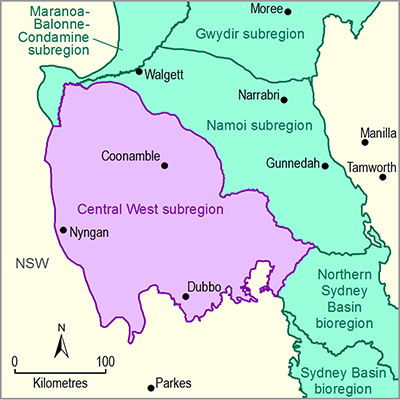CSG resources in the Gunnedah Basin in the Central West subregion are contained within the coal‑bearing formations of the Oxley sub-basin (see Figure 3). Exploration for CSG has identified the Late Permian coals of the Black Jack Group, in particular the Hoskissons Coal, as a potential CSG target (see Figure 20 in companion product 1.1 for the Central West subregion (Welsh et al., 2014) for the stratigraphy of the Gunnedah Basin). The Early Permian Maules Creek Formation (see Figure 20 in companion product 1.1 for the Central West subregion (Welsh et al., 2014)), which is the primary target for Santos Ltd’s Narrabri Gas Project in the Namoi subregion (see companion product 1.2 for the Namoi subregion (Northey et al., 2014)), is either not present in this part of the Gunnedah Basin or its geology is only poorly developed. Results from core wells indicate that the explored area of the Gunnedah Basin in the subregion is not currently prospective for commercial CSG extraction. The coal seams of the Black Jack Group were found to be either severely undersaturated with total gas content generally below 1 m3/t, or with maximum gas content of 4 to 5 m3/t but with high levels of CO2(ESG, 2007a, 2007b, 2010a, 2010b; Santos, 2008, 2009a, 2009b, 2009c, 2009d; Strike Oil, 2003a, 2003b).
Limited coal development in the Coonamble Embayment of the Surat Basin (see Figure 3) means that this area has not been extensively explored for CSG in the Central West subregion. Stewart and Alder (1995, p. 160) considered commercial oil or gas discoveries in the NSW part of the Surat Basin to be more prospective in northern NSW, and Ransley et al. (2012) noted that no commercial oil or gas discoveries have been made in the NSW part of the Surat Basin. A single exploration well has been drilled to assess the CSG potential of the Cretaceous Rolling Downs Group of the southern Surat Basin in the north-western part of the Central West subregion. It intersected a net coal thickness of 6.92 m (including inferior coals) with individual seam thicknesses of 0.25 to 1.58 m. Coal was encountered to depths of 270 m. The gas content of the coals was not measured (Cydonia Resources, 2011).
The Sydney Basin, a small part of which occurs in the south-east of the Central West subregion (see Figure 3), has not been a target for CSG exploration in the subregion to date (as of October 2014). Four distinct zones of gas layering with depth have been identified in the Sydney Basin coal seams including: a CO2 dominated zone; a biogenic, methane-rich zone; a CO2 and methane (mixed) zone; and a methane-rich zone that is likely to be of thermogenic origin (Thomson et al., 2014). Although the shallower biogenic methane may prove a target for CSG production due to enhanced permeability in the coals, the highly variable CO2 content (ranging from less than 10% to 90%) of the mixed gas zones may be problematic for commercial CSG recovery (Thomson et al., 2014). The deeper, thermogenic methane zone may have economic gas content and composition, but coal permeability may be very low in those areas (Thomson et al., 2014).

